NorthSite Contemporary Arts’ 2024 exhibition program celebrates the breadth and diversity of practice in Far North Queensland, in dialogue with artists who have strong connections to the region.
Our second season for 2024 will include:
Anastasia Klose – For thy sake I in love am grown – Drawings, video and performance responding to the Mossman-based artist’s involvement in the campaign to save the rapidly diminishing biodiversity of far north Queensland.
Annika Harding – Flux and Fog – Landscapes of the Atherton Tablelands – Paintings on reclaimed timbers exploring the landscapes around the artist’s Atherton Tablelands home.
Naomi Evans – I AM – Textiles by the Cairns-based emerging artist, serving as a powerful meditation on individual agency in reshaping our own narrative.
Alex Baird Murphy – Magic Compass – Paintings that draw on the artist’s Kuku Yalanji heritage, his interest in music, graffiti, and the urban environment.
EXHIBITIONS
ANASTASIA KLOSE For thy sake I in love am grown
ANNIKA HARDING Flux and Fog: Landscapes of the Atherton Tablelands
ALEX BAIRD MURPHY Magic Compas
EVENTS AND WORKSHOPS
Workshop The Ancient art of Applique with Naomi Evans
Workshop — Painting an experience of place with Annika Harding
IWD | Pressing Topics
This International Women’s Day (IWD) we are celebrating the incredible powerhouse duo, The Ironing Maidens.
The Ironing Maidens, led by Cairns-based Artists Melania Jack and Patty Preece, is an experimental art duo turning domestic objects into electronic instruments to explore themes of gender, domestic labour and technology. In 2022, The Ironing Maidens presented their exhibition ‘Pressing Topics‘ in the NorthSite galleries at Bulmba-ja.
This multi-media installation of projection, sculpture, digital collage, video and sound was a low fi wonderland that smashed pink, Pop and the industrial into a new and playful aesthetic. The work disrupts the ideal proposition of the perfect housewife or the perfect domestic worker and aims to elevate and confront historical and ongoing contemporary issues of discrimination in the domestic labour force.
More recently, The Ironing Maidens have delivered the immersive and interactive performance experience ‘Hot & Heavy’: A speculative fabulation. A non-binary, de-capitalised, de-colonised, de-extinction future imagining.
Where to after NorthSite
Since presenting their exhibition ‘Pressing Topics‘ at NorthSite, The Ironing Maidens work has been presented at IWD Canada – Victoria Society of the Arts in 2023. Later this year they will be exhibiting at ISEA (International Symposium of Electronic Art) in Meanjin / Brisbane.
View the ‘Pressing Topics’ Exhibition at NorthSite
Visit The Ironing Maidens
Pressing Topics. An installation by The Ironing Maidens.
NGURRUWARRA/ DERNDERNYIN: Stone Fish Traps Of The Wellesley Islands
The exhibition catalogue from ‘NGURRUWARRA/ DERNDERNYIN: Stone Fish Traps Of The Wellesley Islands’ is available to download from the link below.
FOREWORD
WORDS: SEAN ULM, JOHN ARMSTRONG AND BERELINE LOOGATHA
Fish traps are central to Kaiadilt, Lardil, Yangkaal and Gangalidda culture, story and very identity.
Fish traps are a key element of material culture shared across the Wellesley Islands region.
This mammoth Ngurruwarra/Derndernyin canvas is a celebration of culture, story and relationship across the seas, lands and skies of the Traditional Owner communities throughout the Wellesley Islands region.
The artwork is a collaboration between ten Kaiadilt, Lardil and Gangalidda artists working together across a massive 20-metre-long by 2-metre-wide canvas. Each artist painted multiple sections of the canvas, with artists negotiating with each other to ensure continuity of story across contiguous elements of the canvas.
Between them, the artists are custodians of intimate knowledge of Country. The most senior Kaiadilt artists of the work, for example, were amongst the last coastal Aboriginal people to be institutionalised in Australia, being forcibly removed from Bentinck Island to a European Mission on Mornington Island in 1948.
One of the first things the Kaiadilt community did when they arrived on Mornington Island was to build their own fish trap near their camp, which is still visible in the intertidal zone in front of the
Kuba Natha Hostel.
This artwork was commissioned by the Australian Research Council Centre of Excellence for Australian Biodiversity and Heritage (CABAH) to celebrate the relationships between Traditional Owners and researchers working on Country.
The artists dedicate this artwork to the late brilliant Dibirdibi Elsie Gabori, who passed away after the work was completed. She is sorely missed.
DOWNLOAD CATALOGUE HERE
VIEW EXHIBITION
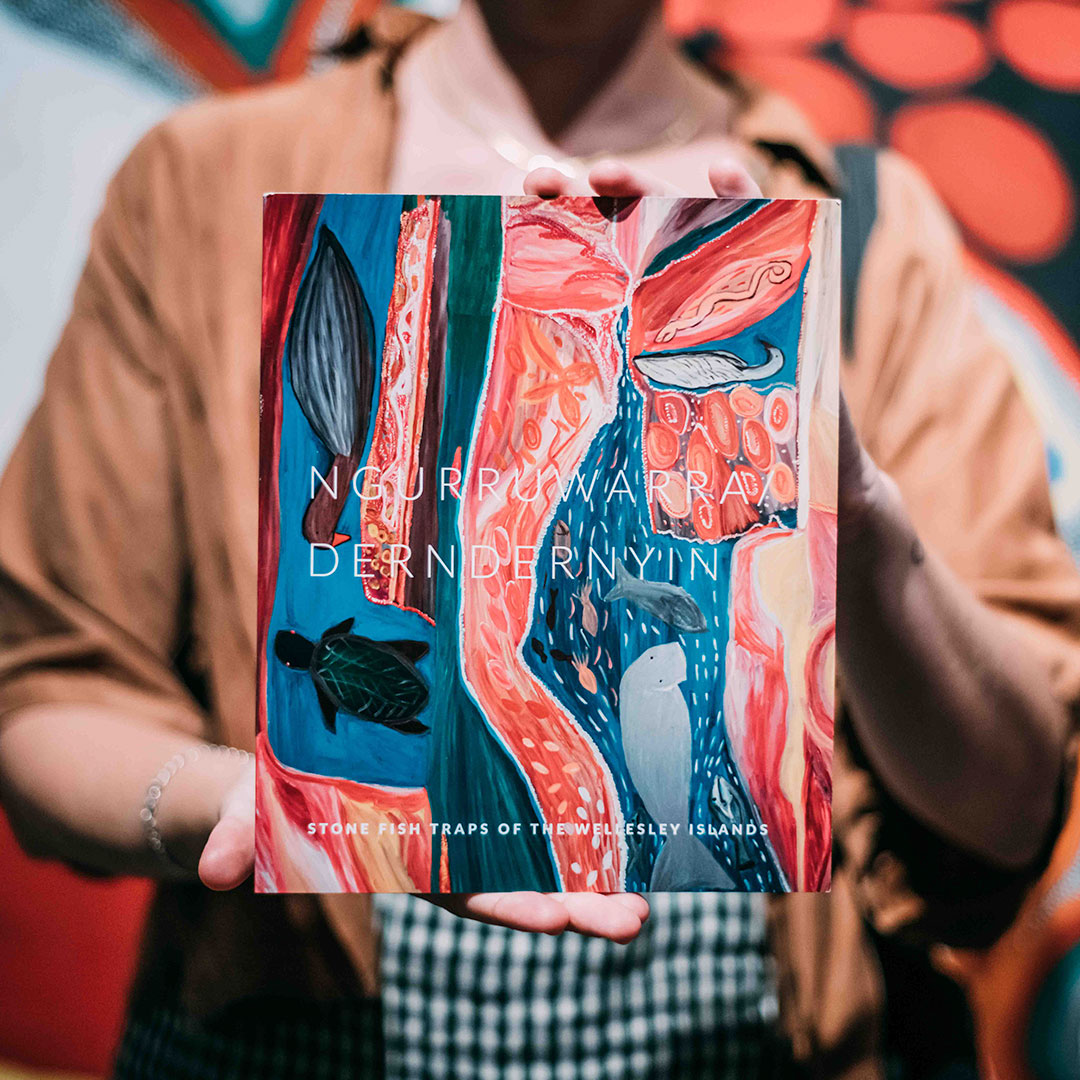
Photographer: Cristina Bevilacqua
Exhibition Season 1 Overview
NorthSite Contemporary Arts’ 2024 exhibition program celebrates the breadth and diversity of practice in Far North Queensland, in dialogue with artists who have strong connections to the region.
Our first season for 2024 will include the inaugural presentation of ‘Ngurruwarra/Derndernyin (stone fish trap)’, a monumental canvas by established and emerging artists from Mirndiyan Gununa Aboriginal Corporation, Mornington Island Art, the outcome of a research project led by the ARC Centre of Excellence for Australian Biodiversity and Heritage (CABAH). Alongside this exhibition will be ‘Conversations with my barista (real or imagined)’, a new photographic and video installation by Cairns-based emerging artist Selina Kudo; and in Gallery Two, ‘Facing Time: 50 Years’ a collaborative exhibition of paintings and drawings by artists and long-term friends Euan Macleod and Cairns-based Geoff Dixon. In addition to our gallery exhibitions, we will present exciting new editions produced through our SpotFire First Nations artist print program, across the Foyer and Long wall spaces.
EXHIBITIONS
NGURRUWARRA/ DERNDERNYIN: Stone Fish Traps Of The Wellesley Islands
Conversations with my barista (Real or imagined)
EVENTS AND WORKSHOPS
Film Screening — Geoff Dixon: Portraits of Us
Workshop — Moments in Monochrome: Crafting Stories with Disposable Camera Diptychs
2024 Exhibition Program

NorthSite Contemporary Arts is excited to announce its 2024 exhibition calendar. Next year’s exhibition program celebrates the breadth and diversity of practice in Far North Queensland, in dialogue with artists who have strong connections to the region.
Our first season for 2024 will include the inaugural presentation of ‘Ngurruwarra/Derndernyin (stone fish trap)’, a monumental painting installation by established and emerging artists from Mirndiyan Gununa Aboriginal Corporation, Mornington Island Art, the outcome of a research project led by the ARC Centre of Excellence for Australian Biodiversity and Heritage (CABAH). Alongside this exhibition will be ‘Conversations with my barista (real or imagined)’, a new video installation by Cairns-based Selina Kudo; and ‘Facing Time: 50 Years’ a collaboration between artists and long-term friends Euan Macleod and Cairns-based Geoff Dixon.
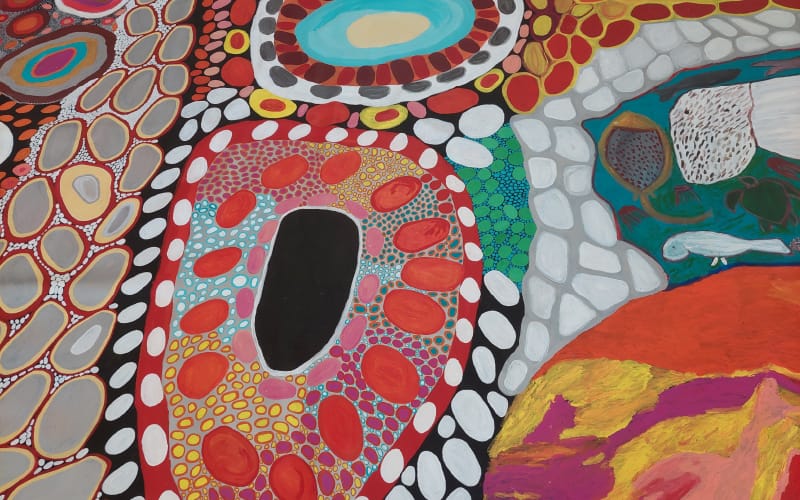
Mirndiyan Gununa Aboriginal Corporation, ‘Ngurruwarra/Derndernyin (stone fish trap)’, (detail), 2023. Image courtesy of Mirndiyan Gununa Aboriginal Corporation.
Season two will focus on the local environment, with Mossman-based artist Anastasia Klose presenting ‘For thy sake I in love am grown’ an ambitious exhibition of new drawings, video and daily performance, responding to the diminishing biodiversity in Queensland and immanent threats to its unique landscapes. Annika Harding’s ‘Flux and Fog: Landscapes of the Atherton Tablelands’ examines moments of tension between the built environment and agricultural landscapes, the lush rainforest ecosystem and associated intense weather patterns.
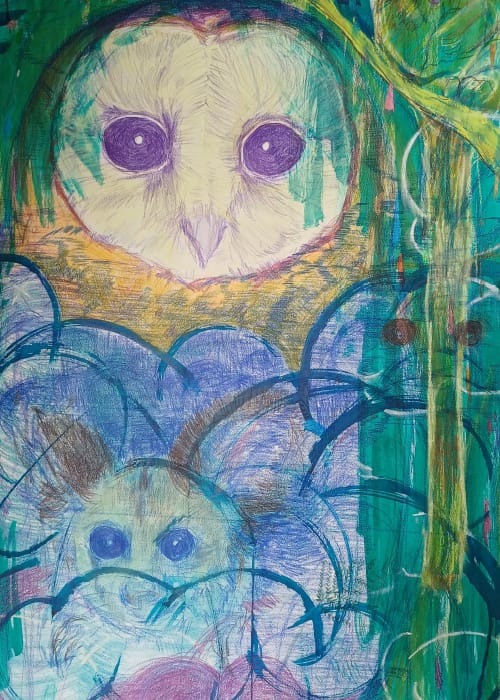
Anastasia Klose, For thy sake I in love am grown, (detail). Image courtesy the artist.
Major gallery exhibitions throughout 2024 will be complemented by project shows on the Long Gallery and Foyer walls, with a focus on early career and First Nations practitioners, supported by NorthSite curator Aven Noah Jr and the wider team. Project wall shows will include outcomes from the Spotfire printmaking development program, a jewellery and small object exhibition curated by Lauren Carter, and the ever-popular annual NorthSite Art Market.
In season three, NorthSite will present a suite of exhibitions by Queensland First Nations artists, coinciding with the Cairns Indigenous Art Fair (CIAF) 2024. This will include the premiere of a major new video and sound installation ‘way to be’ by artist Vernon Ah Kee (Kuku Yalanji, Yidinyji and Guugu Yimithirr), harnessing drone footage and data to showcase the Magnificent Gallery of Rock Art in Western Yalanji country as never seen before. In partnership with Gab Titui Cultural Centre, Thursday Island, Aven Noah Jr will profile exciting new developments in practice from leading and emerging Torres Strait Islander artists.
Season Four showcases experimental approaches to the local landscape, through Oak Beach artist Jill Chism’s ‘Remnants’, an exhibition of recent and existing assemblage and installation works that explore our relationship to an increasingly fragile natural world. Topaz-based artist Luke Aleksandrow presents the third iteration of ‘The Break Project’ entitled ‘Sounds of the Tropics’, documenting the breakage of ceramics made by artists from the region, accompanied by an atmospheric soundscape.
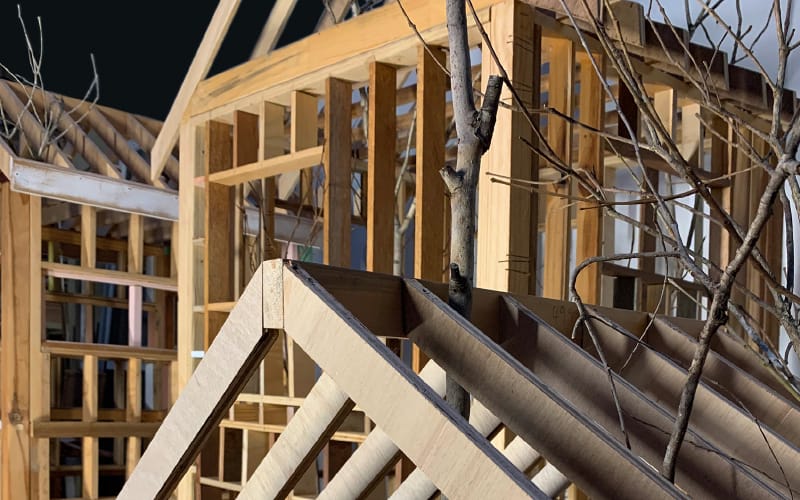
Jill Chism, Remnants, (detail). Image courtesy the artist.
For the final season of the year, NorthSite will present the touring exhibition ‘I, Object’ from the Queensland Art Gallery | Gallery of Modern Art, Brisbane, which considers the many complex relationships Indigenous Australian artists continue to have with cultural objects – from the histories informing their creation to the social and cultural consequences of their collection.
In addition to the onsite exhibition program, NorthSite Contemporary Arts, will present ‘Compositional Utterances’, a site-responsive, collaborative exhibition by Brisbane-based artists Mandy Quadrio, Susan Hawkins and Jan Oliver, whose material-led practices share feminist and ecological concerns. The exhibition is a collaboration between NorthSite and the University of Sunshine Coast Art Gallery, and will be presented at the Court House Gallery in Cairns, supported by Cairns Regional Council. NorthSite will again present an exhibition and art market stall at the Cairns Convention Centre, as part of the CIAF 2024; and is working with artist/curator Taloi Havini to showcase the work of artists from FNQ Sea Country, at Ocean Space, Venice during the 60th Venice Biennale.
ON NOW | See Exhibitions
I am the jellyfish; I am not the jellyfish
Words: Douglas Rushkoff
By calling this collection of exhibitions “Future Nostalgia”, Charlotte Haywood and her collaborators playfully yet soulfully suggest that we might not realize what we’ve got til it’s gone.
In some cases, a natural, paradisal subject or landscape finds itself intruded with the sounds of civilization, as if in the anticipation of its own demise. In others, the human contribution is no less a part of the landscape as the rest of nature: an equal celebrant and plaintiff at the passage of time and inevitable loss. But these are just the obvious narratives, imposed by an observer’s brain desperate to interpret these emergent phenomena through the lens of a traditional story.
On a deeper level, however—on a more daring, dangerous, yet delightful level—Future Nostalgia forces us to transcend the paralyzing dialectic of climate change and the potential horrors of human impact on nature. Instead, we are reminded of the immensity of geologic time, the inevitable cycles of life, and the sweet, silly punctuation that human experience and intentionality interject into the greater swirl of nature.
These works invite us to consider our place among the leaves, shells, jellyfish, plants and seeds. Are we just part of the dance of matter and life, complexity and decay, entanglement and release? Must we accept our essential meaninglessness to achieve a rapproachment with the rest of life? Or do we bring purpose and forethought, design and desire into the mix? What makes wood into “chair,” and who besides a potential human sitter knows this has even happened?
Does our ability to observe and reflect upon the swirl guarantee us unique privilege among the many forms? In spite of our innumerable crimes against nature and pretty much every other living -or formerly living -species, don’t we hold a special place as thinking, observing, singing, and dancing human beings?
Does our need to confess and mourn absolve us of even some portion of our guilt? Or what about simple humor? Doesn’t our ability to identify and laugh, to be silly and clever, to recognize a bunny in woven straw or to re-invent the orchid as mycelia merit some recognition of specialness and selfhood?
How will we be remembered, and how will we remember ourselves? Will we be nostalgic for that moment in evolutionary history when we thought ourselves to be unique among earthlings? Or will we simply be nostalgic for our long lost ability to recognize ourselves in the patterns of nature? Will we remember what it was like to experience ourselves in solidarity with all living things? Or will we be obsessed with our former ability to imagine and believe in our own separateness?
Or given our current trajectory, must we do all that remembering and reminiscing right now, both pre-mourning and pre-celebrating a past we will not live long enough to look back on? Perhaps. But I prefer to take a different message from Future Nostalgia: While times are hard and our separation from the cycles of nature may appear to be irrevocable, we will one day retrieve the social, cultural, and spiritual mechanisms of our indigenous ancestors—finally reconciling our place within nature with our inherent alienation as self-aware beings.
Positive futurism, then, is a practice of looking ahead while also bringing forward the past into that imaginary. And while that would likely induce a sense of vertigo in the time traveller, the grounded human artist experiences it instead as more of an emotional mobius strip: a nostalgia for what has yet to be.
Douglas Rushkoff is an American media theorist, writer, columnist, lecturer, graphic novelist, and documentarian. He is best known for his association with the early cyberpunk culture and his advocacy of open-source solutions to social problems.
Rushkoff is most frequently regarded as a media theorist and is known for coining terms and concepts including viral media (or media virus), digital native, and social currency.
Rushkoff is currently Professor of Media Theory and Digital Economics at the City University of New York, Queens College. He has previously lectured at The New School University in Manhattan[5] and the Interactive Telecommunications Program at New York University‘s Tisch School of the Arts, where he created the Narrative Lab.[6] In 2012, Rushkoff was declared the sixth most influential thinker in the world by MIT Technology Review.
LINKS
Planetary Gestures travels to Melbourne
Planetary Gestures was exhibited at NorthSite Contemporary Arts earlier this year. Curated by Tess Maunder, the exhibition explores ideas surrounding ecological systems, ancient knowledge, celestial blueprints and tidal movements across the land, sea and sky known as Australasia, part of the wider Asia-Pacific and the ‘Great Ocean’. The exhibition includes work by artists Amrita Hepi, Susie Losch, Raqs Media Collective, Rirkrit Tiravanija, Jimmy John Thaiday and Trevor Yeung.
We’re thrilled to see Planetary Gestures touring to Walker Street Gallery and Arts Centre in Dandenong, Melbourne. The opening preview is this Saturday, 23 September from 2PM-4PM with the exhibition running until 3 November 2023.
Location: Walker Street Gallery and Arts Centre, Cnr Walker and Robinson streets, Dandenong
Opening Hours: Tues-Fri 12pm – 4pm
Exhibition runs from 26 SEPTEMBER 2023 until 3 NOVEMBER 2023
LINKS
Claudine Marzik’s Undara Paintings
Words: Ross Searle
The opportunity to write about Claudine Marzik’s impressive art practice is indeed a pleasure. On first seeing her work I was impressed by its refined but energetic gestural mark-making that appeared to contain a language that was both familiar but unique in the way that it responded to the particularities of the ‘northern’ seasonal environment. She is perhaps best known for a series of paintings relating to the seasons which reference the dynamics of seasonal and changing weather patterns from quite subtle shifts to extreme conditions that have major impacts on the land. The sense of ‘familiarity’ I first recognised in her painterly gesture in the early 1990s no doubt relates to the influences of ‘gestural’ abstraction that found its place in American and European painting after World War II. A process and not a movement, it continues to be shaped by European artists such as Gerhard Richter and Australians Aida Tomescu, Ildiko Kovacs and of course, Claudine Marzik.
Her capacity to encapsulate the intensity of the environment of northern Australia has been noted by writers Gavin Wilson who observed; ‘her work reaches deep into her emotional reserves to construct images that suggests states of mind’1 and Ingrid Hoffman who wrote about the impact of knowing the landscape that ‘comes out of time spent discerning the morphology of plants and their distilled colour, their intricate prickliness, their smooth shapes, their grace and vulnerability’.2 This ability to zoom in and out of the landscape to see it not only in terms of its parts but also as a system that communicates an emotional state is intriguing.
Recent projects include The Body Language of Plants which came about from working with materials collected as part of herbarium specimens. The science-art nexus continues with the current exhibition.
This new body of work relates to the Undara Volcanic National Park, a unique geological site she first visited in 2017. ‘Undara’ is an Aboriginal word meaning ‘long way’. The park protects a system of 190,000-year-old lava tube caves, the longest in the world. Located 264 km south-west of Cairns, they are the result of an eruption, spewing molten lava over the surrounding landscape. The lava flowed rapidly down dry riverbeds with the top, outer layer cooling and forming a crust, while the molten lava below drained outwards, leaving behind a series of hollow tubes.
An almost autonomous natural ecosystem, Claudine was captivated by the cave-system of the lava tubes and the depositions on the cave ceilings and walls. Drawing ideas from earlier visits and a recent residency supported by Discovery Holiday Parks through Undara Experience, resulted in a new series of work. With each visit she took photographs and did onsite drawings, made notes, and compiled a visual lexicon of the site – an iterative process that allowed her to hone her ideas and images. In recent years, artists like Claudine have adopted a profusion of methods, practices, and experiences to enhance the interface between the visual arts and environmental-scientific concerns. In Claudine’s case, she has made an especial study of the morphology and topography of Undara.
The sensation of being in a submerged environment with its dark corners and surprising patches of light that break through the ceilings is manifested in the tonal gradients she employs in the paintings on canvas and paper for this exhibition. The palette she employs is influenced by the various minerals in the caves including basalt, iron oxide and calcium carbonate. The underlining minerals reveal tones of red, yellow, and green contrasting with the black rock basalt intrusions, the lighter toned calcium carbonate and richer iron oxide. A recurring compositional device that is used in several of the paintings is a doorway shape, as if looking out from the darkness of the cave into the light. We see this clearly in the large paintings which alternate between looking into the caves and out into the open. Claudine reflects that ‘being inside the cave looking towards the exit which can be seen about 50 meters away, is a captivating view. It releases emotions (and) it’s like a sensation of new life and hope. Back to safety, back to the known from the unknown, back to the light from the dark. Back from the cold to the warm.’3
The exhibition has been grouped to reinforce compositional ideas based on the geological forms, surface patterns, depositions, graffiti, and textures that appear on walls and ceilings. Far from being a static environment, natural formations from the speleothem deposits continue to accumulate to form subtle new layers not unlike some of the paintings which are worked and layered like strata. Some of the artworks are tightly framed views of the deposition of minerals on the tube walls and ceiling as if looking through a photographic lens which at once makes everything equally comparable without a reference point.
Undara is the perfect place for her to test new approaches to the landscape. In Claudine’s hands her artworks possess a tight undulant pattern reminiscent of natural surfaces found in this unique landscape. The effect of this is to make the texture not only closer to that of the actual cave surfaces but also to overcome of what Gerhard Richter suggests is the over importance of edges and borders; to make everything equal and allow the viewer’s brain to impose its own structure on the artwork.4 Her way of working at Undara was to create sets of visual references and once in the studio this material was used to create this series of works that reference her macro-micro responses to surface textures, dramatic geological intrusions, and mineral accretions. Although some works contain a complex layering of paint pattern and form, in general there is a looseness in the shapes and forms and a more free, spontaneous approach.5 It is a thrilling body of work.
Words: Ross Searle
Footnotes
1 Gavin Wilson, Country and western landscape re-imagined, exhibition catalogue, Perc Tucker Regional Gallery, Townsville, 2015, p 40.
2 Ingrid Hoffman, Seed to seed, exhibition catalogue, KickArts Contemporary Arts, Cairns, 2012.
3 Claudine Marzik email to author, 7 August 2023
4 Misha Ketchell, Nature makes abstract visual art more captivating. The conversation, March 25, 2014
5 Claudine Marzik, ibid
LINKS:
Calling all Queer artists | Cairns Pride Art Exhibition 2023
Jamie Cole and Sally Brown are excited to curate the Cairns Pride Art Exhibition 2023 at Tanks Arts Centre. Along with the Tanks Team, they aim to bring together LGBTIQ+ Sistergirl and Brotherboy artists from not only Cairns and FNQ, but from all over Australia.
Artists at all stages of their careers are invited to submit works for the October 2023 exhibition.
Expressions of interest: Email Jamie Cole at artbyjamiecole@gmail.com before August 18, 2023 for a copy of the Artwork Entry Form.
This is an LGBTIQ+ event and works submitted should celebrate and reflect our LGBTIQ+ Sistergirl and Brotherboy communities. This event is kindly supported by Cairns Tropical Pride, 2Spirits, the Queensland Council for LGBTI Health and Cairns Regional Council.
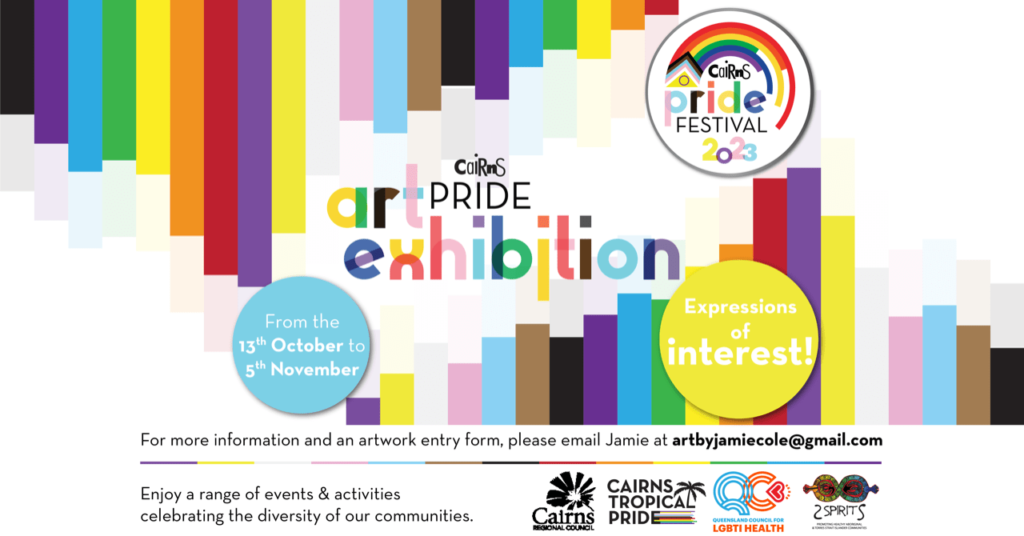
Image courtesy of Jamie Cole.
The Ironing Maidens World Premiere in Cairns plus International Recognition at NIME
From December 2023 to January 2024, The Ironing Maidens (Melania Jack and Patty Preece) presented their sound, digital art and projection installation work – Pressing Topics at NorthSite Contemporary Arts. The debut of this work was well received at NorthSite and the workshop presentation explaining the work; Oscillations attracted a huge audience for a Saturday Morning of almost 70 participants. Ironing certainly still resonates with many people, but ironing sound is a unique experience in itself.
The audiovisual installation, Oscillations, turns irons and ironing boards into electronic instruments, in an attempt to deconstruct stereotypical ideas of gender and its assigned roles. The work aims to investigate the relationships we have with domestic objects and ponder their structures and significance through the design and performance of an interactive ecosystem. The project uses a sonic cyberfeminist lens to critically explore aesthetic and relational hierarchies at the intersection of sound, gender and technology.
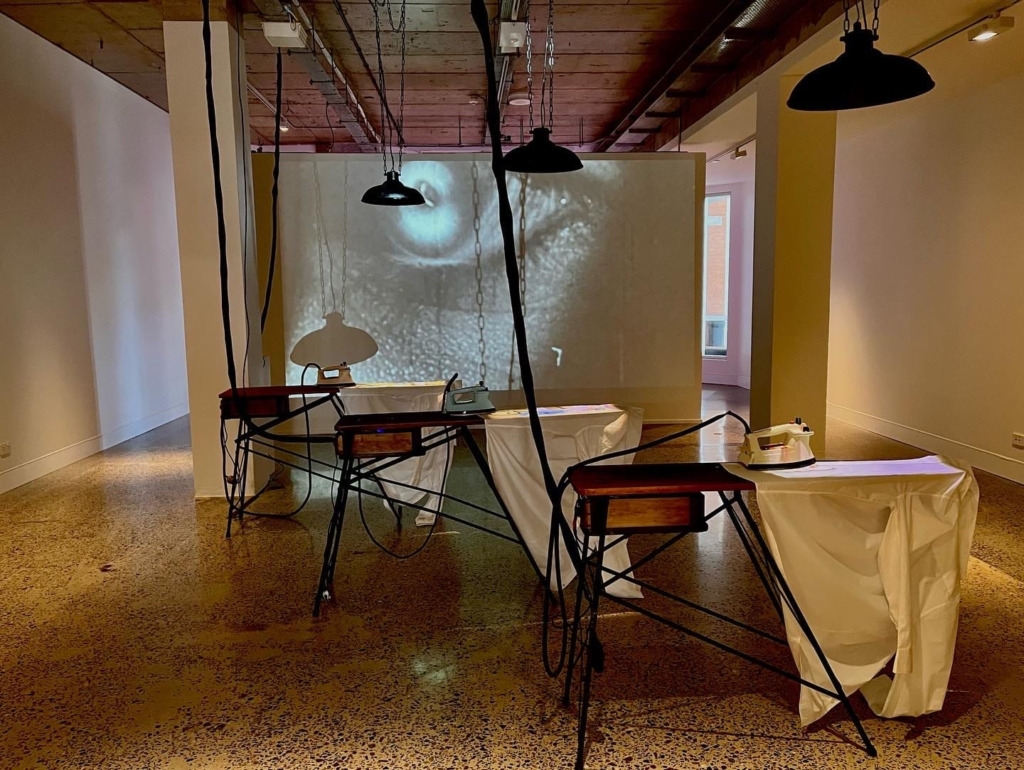
Three irons and ironing boards have been hacked and retrofitted with embedded electronic instruments that together create a complex feedback network. While the audience is invited to physically interact with the irons instruments and manipulate samples, the sonic state of the installation also changes based on the audio information detected in the environment. Projections onto the surface of the ironing board expose the labor within.
“This opportunity to present the work in Cairns has been so important to the development of the work. Being able to see people interacting and responding to the instruments at NorthSite provided us with an insight into the experience of the audience, and gave us more ideas on how to refine the instruments to improve that audience experience. We are so thankful to NorthSite for this opportunity and support”
– Patty Preece.
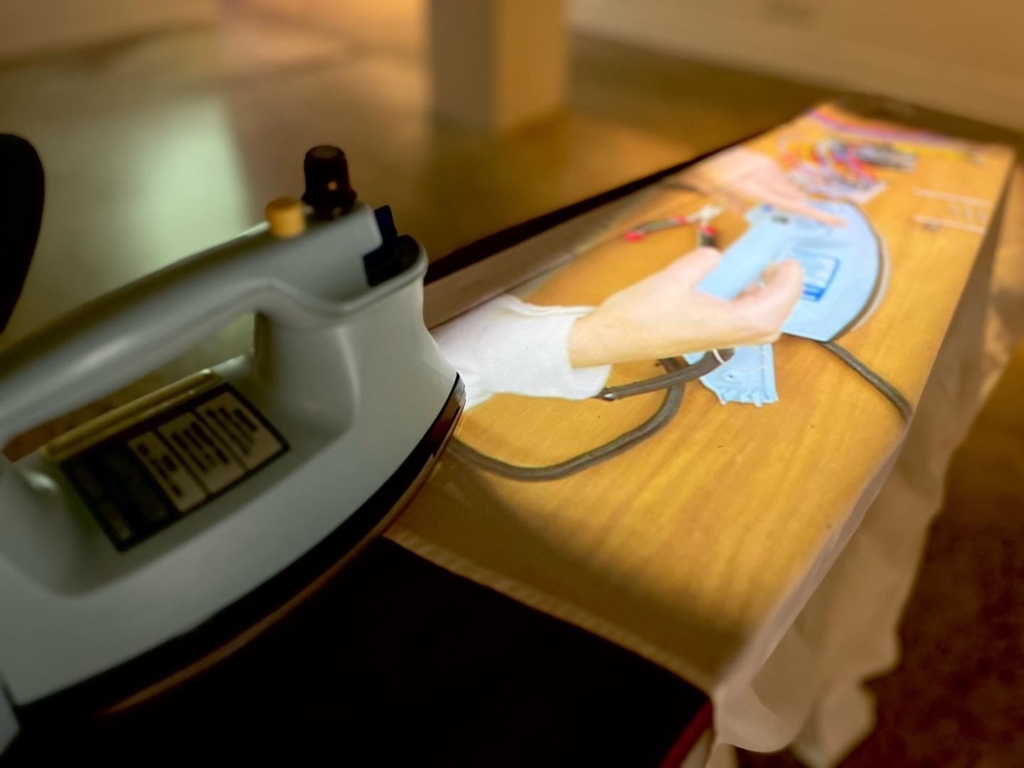
The work was then presented at the International Conference of NIME (new instruments for musical expression) in Mexico City in May 2023. Joining hundreds of experimental, digital instrument makers from around the world, Patty and Melania presented their paper – Oscillations: Composing a Performance Ecosystem through a Sonic Cyberfeminist Lens and installed this work in the foyer of the Center for Digital Culture, in La Condessa. The work was recognised through two awards, the paper receiving ‘The Pamela Z award for innovation’, and the installation receiving the ‘best installation award’.
Now the duo bring the ironing instruments back to Cairns in a hybrid band of irons and synthesisers, in the next phase of the project – Hot & Heavy – an immersive experience that is “part gallery, part performance and part banging dance party”. In a World Premiere at The Tanks Art Centre.
Hot & Heavy is an aural, visual and sensory experience that invites you to lose your friends, go deep and shake free. Explore this queer new world where domesticity has been made strange, appliances are defamiliarised, and the casual horrors of human production lines and capitalist consumption are vividly transformed. In a landscape of real world glitches, the lines between performer and audience blur and break, bodies move en masse and the unifying power of a dance floor infects the crowd. Hot & Heavy is the search for multiple new futures, yearning to find utopia within the banging beat of a broken down washing machine.
“In previous live shows we [The Ironing Maidens] have explored themes such as planned obsolescence and domestic labour, but in this new work we wanted the opportunity to really expand, to really push ourselves and the work. We wanted to investigate the kind of world we are living in now; within this capitalist system, and explore what kind of alternatives we could imagine for our collective futures, we wanted to explore what this could feel like, what it might sound like.”
– Melania Jack
“We have expanded the creative team and have been working with international choreographic director Leigh-Anne Vizer and a team of dancers to develop the worlds that the audience will explore. We are also working with the Cairns community, through a series of workshops in the lead up to the performance so that we can skill share in music and dance, and invite people to come and create with us and join us in the live performance”.
– Patty Preece
This event is an Auslan Interpreted Performance. There will be a meeting place on entry for Auslan interpretation during the first half of the show. The second half of the show the interpreter will be onstage. Please contact for more details
Show might include atmospheric haze and strobe effects.
Workshops in the lead up to the show are open to the public and start this week (Monday 31 July 2023). Meet the cast, learn some new skills, and join the community ensemble. There is a fundraiser running to make these workshops free and accessible to marginalised groups in the community. Head to The Australian Cultural Fund website and search for The Ironing Maidens – $15 can support a scholarship place in the workshop. Click here to support.
This new work has been developed in Cairns through commissions from the Local Giants Program; a partnership between Regional Arts Australia, PAC and Performing Lines, and the Tanks Arts Centre and Cairns Regional Council. Development funded by the Australia Council for the Arts. Community engagement funded by Cairns Regional Council through the RADF Major Round. The project is funded and managed by Shiny Shiny Productions, a feminist, queer led, regional production company.
SHOW DATES: Friday 25th August 8pm – Cairns Tanks Arts Centre
Sunday 27th August 1pm
Tickets Live Show – $27.50 & $32.50
Support – $15 can support a scholarship place in the workshop
LINKS

